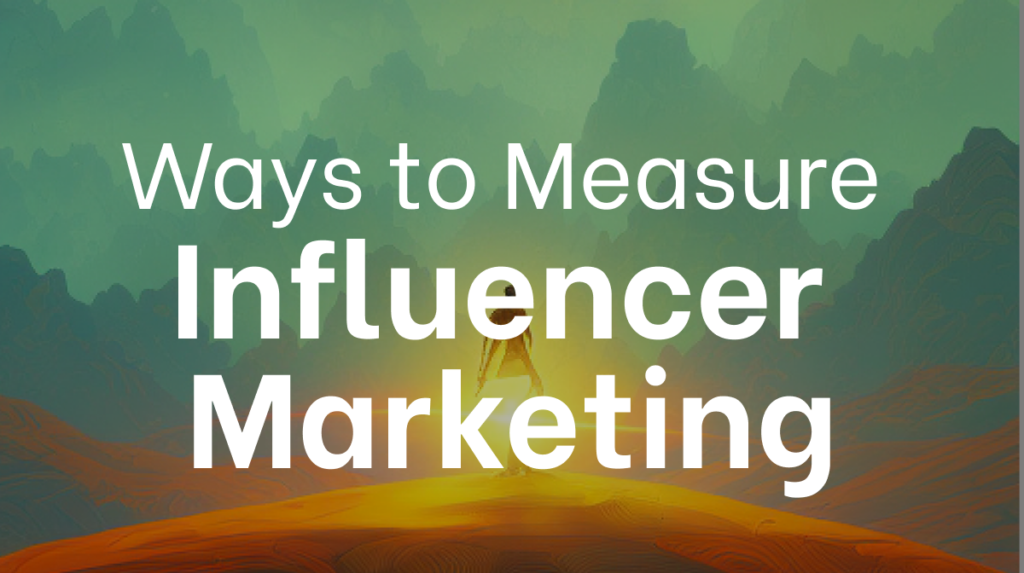Influencer marketing is a great way to reach your target audience and build trust in your brand. However, it’s important to measure influencer marketing efforts to ensure you’re getting the best return on investment (ROI). In this article, we’ll discuss the different methods for measuring the success of your influencer campaigns, including the most important KPIs. We’ll also explore how to accurately interpret the data and use it to optimize your campaigns for better performance.
Identify Your Goals

Before you can measure the success of your influencer marketing campaigns, you need to identify what it is you’re trying to accomplish. Are you trying to increase brand awareness, increase engagement, drive traffic or generate leads? All of these goals can be accomplished through influencer marketing, but they require different approaches and strategies.
Having a clearly defined goal will help you determine the metrics needed to measure your influencer marketing campaigns. Here are a few examples of metrics that can help you measure the success of your influencer marketing campaigns, depending on your objectives:
- Brand Awareness: Reach (number of viewers) and Engagement (likes, comments etc.)
- Traffic: URL clicks and Impressions
- Leads: Sales (conversions) and Leads generated from the campaign
Understand Your Audience
Measuring your influencer marketing efforts starts with understanding your audience. That means looking at metrics like age, occupation, location, and interests to figure out who you should be targeting in the first place. Knowing what demographic the influencers you want to work with reach will be critical to help you track how effective they are in terms of converting their followers into customers.
It pays to look beyond surface-level metrics by also getting a better understanding of users’ overall behavior on social media channels. Tracking their activity as well as how they interact with the influencers you are working with can help you identify not just which influencers are bringing in conversions, but also which ones may be resonating more with your target audience.
That information can then be used to refine your campaigns and make them even more effective over time. For instance, if you find that one type of content is more successful than another, adjust accordingly—change up the imagery or content themes and see if that yields more conversions from the same influencers.
Use Engagement Metrics to Measure Success

Measuring the success of your influencer marketing campaigns is essential – it helps to give you an idea of what works and what doesn’t, and allows you to plan better campaigns in the future. There are many metrics that you can use to measure your campaign’s success, but engagement metrics are one of the most important.
Engagement metrics focus on the interactions between viewers and influencers. Popular metrics include:
- Reach: The total number of unique people who saw the post or video
- Engagement rate: The ratio of people who actually interacted with the post to those who saw it
- Likes, shares, and comments: Self-explanatory
- Click-through rate (CTR): The ratio of people who clicked on a link in a post or video versus those who saw it.
By looking at these metrics and comparing them between posts and influencers, you can gain valuable insight into how successful your campaign is. This will help you make more informed decisions about future campaigns that may result in higher returns for your business.
Monitor Campaign Reach and Exposure

As an effective way to measure influencer marketing, it is important to monitor your campaign for reach and exposure. Reach is the number of people who were exposed to your message, while exposure is the amount of times someone interacted with your message.
Here are some key metrics to track and analyze:
Impressions
An impression is when a post or content has been seen, oftentimes referred to as reach. This metric indicates how many people have been exposed to the campaign by viewing it through various media channels.
Engagement Rate
Engagement rate shows how much a user interacted with the content – such as likes, comments, shares or retweets – after being exposed to it. This key metric measures an audience’s reactions and engagement levels.
Click-through Rate (CTR)
CTR shows how many users who have seen your influencer’s post acted upon it by clicking on a link or taking an action, such as signing up for an email list or buying a product. This metric reveals if you are successfully converting followers into customers.
Analyze Conversions & Subsequent Sales
Measuring ROI is essential when assessing the success of influencer campaigns. However, not all measurements are created equal. The most accurate way to measure influencer marketing campaigns is by tracking conversions and subsequent sales.
Fortunately, there are plenty of tools available to help with this task, including:
- Customized tracking links: Having influencers promote a specific product or landing page that features a unique URL will help you accurately track the number of conversions generated from that campaign.
- Engagement metrics: Track how many people are engaging with the content shared by your influencers, including likes, shares, and comments.
- Social media analytics: Analyze how many impressions your content achieved across various social media platforms, as well as the reach and engagement it gained among followers of your influencers.
- Dedicated landing pages & campaign-specific hashtags: Create a dedicated landing page for each individual campaign and use specific hashtags on social media posts related to those campaigns to help track the success of each one.
By taking advantage of these tools, you can get an accurate picture of how effective your influencer marketing efforts have been in terms of generating conversions and sales.
Use A/B Testing to Track Performance

When it comes to measuring the success of your influencer marketing efforts, A/B testing can be a powerful tool. A/B testing allows you to test two separate versions of the same campaign and measure the results. For example, if you’re running a promotion with two different influencers, you can use A/B testing to compare the results and determine which influencer is driving more sales.
A/B testing is particularly useful for tracking the performance of an influencer campaign in real time. By measuring how many people are taking action after seeing an influencer post or engaging with them on social media, you can quickly assess which messages resonate most with your audiences and make adjustments if needed. Tracking metrics such as website visits, sales conversions, followers gained, and brand mentions over time can also help you understand what works best for your campaigns.
Finally, A/B testing is also a great way to compare the performance of different content formats by seeing which ones drive more engagement or leads. This could include comparing images versus videos or posts featuring a product versus those that don’t—allowing you to maximize the impact of each piece of content.
Conclusion
With an increasing focus on influencer marketing, marketers have to have the right metrics in place to measure their efforts. A well-thought-out measurement strategy should include metrics such as reach and engagement, website traffic, sentiment analysis, brand recall, and more. By setting up objectives and utilizing the right metrics, marketers can accurately track the performance of their influencer campaigns and maximize the return on their investments.
The right metrics also enable marketers to compare, analyze, and compare data over different campaigns, allowing them to make data-driven decisions that can ultimately lead to better ROI. Ultimately, the ultimate goal remains to build relationships with influencers and create meaningful connections with the target audience that drive measurable outcomes.

